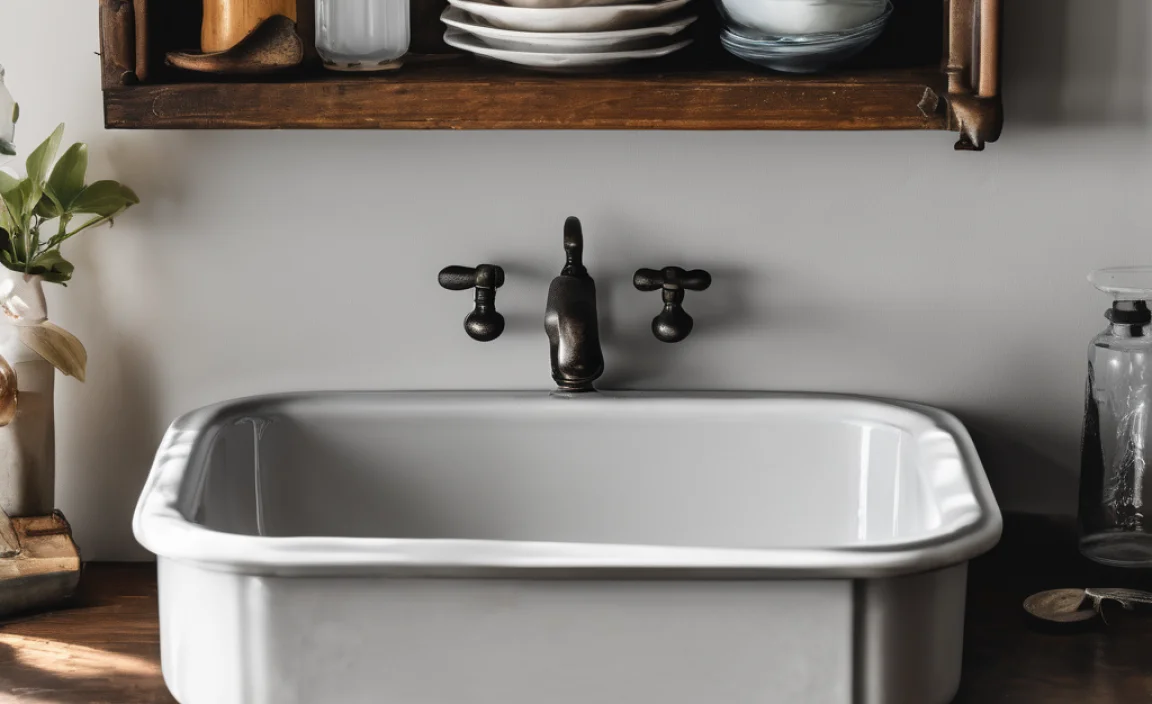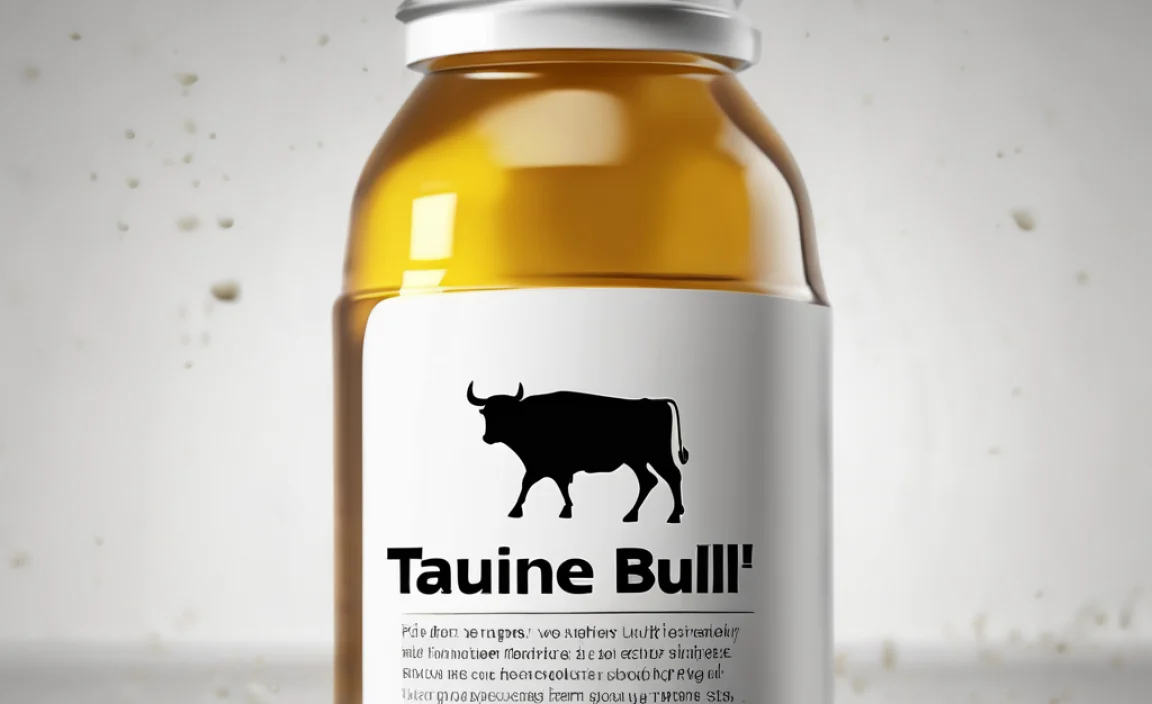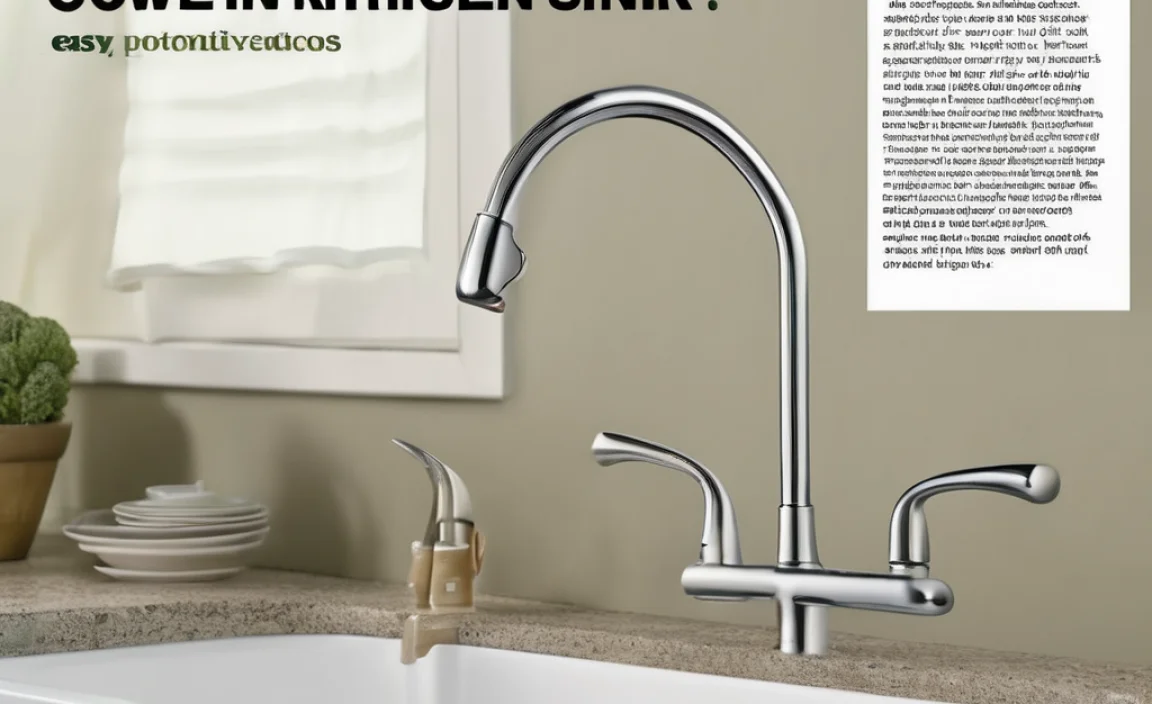An old cast iron sink can be worth anywhere from $50 to $1,500 or more, depending on its condition, age, style, and rarity. Antique sinks in excellent condition are highly desirable and command the highest prices. Even a well-used but functional sink can fetch a decent sum, especially if it has unique features or a sought-after design.
Ever wondered if that old cast iron sink in your basement is worth something? You’re not alone! Many homeowners find these relics during renovations and wonder if they’ve struck gold. Figuring out the value of an old sink can be tricky, but don’t worry! This guide will walk you through everything you need to know, step by step.
We’ll explore what makes a cast iron sink valuable, how to assess its condition, and where to find potential buyers. You’ll learn how to clean and prepare your sink for sale, and understand the factors that affect its price. Let’s get started and uncover the hidden value of your cast iron sink!
Factors That Determine the Value

Several factors influence the value of an old cast iron sink. Let’s break them down:
- Condition: This is the most crucial factor. A sink in excellent condition with minimal wear and tear will be worth more.
- Age and Rarity: Older sinks, especially those from specific historical periods or manufacturers, can be highly valuable. Rare designs or unusual features also increase value.
- Style and Design: Certain styles, like farmhouse or pedestal sinks, are more popular and command higher prices.
- Size and Dimensions: Unique or hard-to-find sizes can be more valuable, especially if they fit specific restoration projects.
- Original Hardware: Having original faucets, legs, or other hardware can significantly increase the sink’s value.
- Manufacturer: Some manufacturers, like Kohler or Standard, are known for quality and design, adding to the sink’s value.
Assessing the Condition of Your Cast Iron Sink

Before you get too excited, take a close look at your sink. Here’s what to check:
- Rust: Check for rust spots, especially around the drain and edges. Minor surface rust can be cleaned, but deep rust can significantly lower the value.
- Chips and Cracks: Examine the enamel coating for chips and cracks. Small chips might be repairable, but large cracks can be a deal-breaker.
- Stains: Look for stubborn stains that won’t come off with regular cleaning.
- Overall Cleanliness: A clean sink always looks better! Give it a good scrub to remove dirt and grime before assessing its condition.
- Functionality: If the sink is still installed, check if the drain works properly and if there are any leaks.
Identifying the Sink’s Style and Features

Knowing the style and features of your sink can help you determine its value. Here are some common styles:
- Farmhouse Sink: These sinks are large and deep, often with an exposed front. They are highly sought after for their rustic charm.
- Pedestal Sink: These sinks stand on a pedestal base and are common in older homes.
- Wall-Mounted Sink: These sinks are mounted directly to the wall, saving floor space.
- Drop-In Sink: These sinks are designed to drop into a countertop.
- Corner Sink: These sinks are designed to fit into a corner, maximizing space.
Also, look for unique features like:
- Double Basin: Sinks with two basins are often more desirable.
- Integral Drainboard: A built-in drainboard adds convenience and value.
- Soap Dishes: Original soap dishes can be a nice touch.
- Unique Colors: While white is common, sinks in vintage colors like pink, green, or blue can be more valuable.
Researching the Manufacturer and Age
Identifying the manufacturer and age of your sink can significantly impact its value. Here’s how to do it:
- Look for Markings: Check the underside of the sink, the faucet area, or the drain for any manufacturer’s marks or stamps. Common manufacturers include Kohler, Standard, American Standard, and Crane.
- Search Online: Once you find a marking, search online for the manufacturer and any associated model numbers. This can help you determine the age and original specifications of the sink.
- Consult Online Forums: Online forums dedicated to antique plumbing fixtures can be a great resource. Post photos of your sink and ask for help identifying it.
- Check Antique Guides: Antique guides and price lists can provide information on the value of sinks from specific manufacturers and periods.
Cleaning and Preparing the Sink for Sale
A clean and well-presented sink will always fetch a better price. Here’s how to prepare it for sale:
- Remove Dirt and Grime: Start by washing the sink with warm, soapy water. Use a mild dish soap and a soft cloth or sponge.
- Tackle Stains: For stubborn stains, try a paste of baking soda and water. Apply the paste to the stain, let it sit for a few minutes, and then scrub gently.
- Remove Rust: For surface rust, use a rust remover specifically designed for cast iron. Follow the instructions carefully and wear gloves and eye protection.
- Polish the Enamel: Use a gentle enamel polish to restore the shine. Apply the polish with a soft cloth and buff until the enamel is smooth and glossy.
- Clean Hardware: Clean any original hardware, such as faucets or legs, with appropriate cleaners. Polish metal parts to restore their shine.
- Photograph the Sink: Take clear, well-lit photos of the sink from all angles. Highlight any unique features or details.
Where to Sell Your Old Cast Iron Sink
Now that your sink is clean and you know its value, it’s time to find a buyer. Here are some options:
- Online Marketplaces: Sites like eBay, Craigslist, and Facebook Marketplace are great for reaching a wide audience.
- Antique Stores: Local antique stores may be interested in buying your sink, especially if it’s a rare or unique model.
- Architectural Salvage Yards: These yards specialize in reclaimed building materials and often buy old sinks.
- Online Forums and Groups: Niche forums and social media groups dedicated to vintage plumbing fixtures can be a good place to find interested buyers.
- Auction Houses: For particularly rare or valuable sinks, consider selling through an auction house specializing in antiques and collectibles.
Pricing Your Sink for Sale
Setting the right price is crucial for a successful sale. Consider these factors when pricing your sink:
- Research Comparable Sales: Look for similar sinks that have recently sold on eBay or other online marketplaces. This will give you a good idea of the current market value.
- Factor in Condition: Adjust the price based on the condition of your sink. A sink in excellent condition will command a higher price than one with significant wear and tear.
- Consider Rarity: If your sink is rare or has unique features, you can price it higher than a more common model.
- Be Realistic: While it’s tempting to overprice your sink, being realistic will increase your chances of making a sale.
- Be Open to Negotiation: Be prepared to negotiate with potential buyers. Setting a slightly higher price than you’re willing to accept can give you some wiggle room.
Negotiating and Closing the Sale
Once you’ve found a potential buyer, it’s time to negotiate and close the sale. Here are some tips:
- Be Responsive: Respond promptly to inquiries from potential buyers.
- Provide Detailed Information: Answer any questions the buyer has about the sink’s condition, dimensions, and features.
- Be Honest: Be honest about any flaws or imperfections in the sink.
- Negotiate Fairly: Be willing to negotiate on price, but don’t be afraid to stand your ground if you feel your price is fair.
- Arrange for Pickup or Delivery: Discuss pickup or delivery options with the buyer. Cast iron sinks are heavy, so you may need to help with loading and transportation.
- Get Paid: Agree on a payment method and ensure you receive payment before releasing the sink. Cash, PayPal, or other secure payment methods are recommended.
Alternatives to Selling: Repurposing Your Cast Iron Sink
If you decide not to sell your old cast iron sink, there are plenty of creative ways to repurpose it. Here are a few ideas:
- Garden Planter: Convert the sink into a unique garden planter. Fill it with soil and plant flowers, herbs, or vegetables.
- Outdoor Bar: Use the sink as part of an outdoor bar or kitchen area. It can serve as a wash basin or a place to chill drinks.
- Pet Bath: Turn the sink into a pet bath station. It’s the perfect size for washing dogs or other animals.
- Laundry Sink: Install the sink in your laundry room for hand-washing delicate items.
- Decorative Feature: Simply display the sink as a decorative feature in your garden or home. Its vintage charm can add character to any space.
The Environmental Benefits of Salvaging and Reusing
Salvaging and reusing old cast iron sinks is not only a great way to make some money, but it’s also environmentally responsible. Here’s why:
- Reduces Landfill Waste: By reusing an old sink, you’re preventing it from ending up in a landfill.
- Conserves Resources: Manufacturing new sinks requires a lot of energy and resources. Reusing an old sink reduces the demand for new production.
- Preserves History: Old cast iron sinks are often historical artifacts. Salvaging and reusing them helps preserve a piece of the past.
- Promotes Sustainability: Reusing and repurposing items is a key component of sustainable living.
Examples of Cast Iron Sink Values
To give you a better idea, here’s a table with examples of cast iron sink values based on different factors:
| Type of Sink | Condition | Approximate Value | Notes |
|---|---|---|---|
| Farmhouse Sink | Excellent | $800 – $1500 | Fully restored, original hardware |
| Pedestal Sink | Good | $200 – $400 | Minor wear, original pedestal |
| Wall-Mounted Sink | Fair | $50 – $150 | Some rust, needs cleaning |
| Double Basin Sink | Excellent | $600 – $1200 | Double basin, fully functional |
| Corner Sink | Good | $150 – $300 | Unique corner design, good condition |
Common Pitfalls to Avoid
Selling an old cast iron sink can be rewarding, but it’s important to avoid common pitfalls:
- Overpricing: Don’t overestimate the value of your sink. Be realistic about its condition and market demand.
- Poor Presentation: A dirty or poorly presented sink will not attract buyers. Take the time to clean and prepare it properly.
- Inaccurate Descriptions: Provide accurate and detailed descriptions of the sink, including its condition, dimensions, and any flaws.
- Ignoring Inquiries: Respond promptly to inquiries from potential buyers. Ignoring inquiries can lead to missed sales opportunities.
- Unsafe Handling: Cast iron sinks are heavy and can be dangerous to move. Use proper lifting techniques and get help if needed.
Step-by-Step Guide: Determining Your Sink’s Worth
Let’s recap the steps to determine your sink’s worth.
- Assess Condition: Check for rust, chips, cracks, and stains.
- Identify Style: Determine if it’s a farmhouse, pedestal, wall-mounted, or other style.
- Research Manufacturer: Look for markings and research the manufacturer online.
- Clean Thoroughly: Clean the sink to improve its appearance.
- Research Comparable Sales: Find similar sinks that have recently sold online.
- Price Realistically: Set a price based on condition, rarity, and market demand.
- Choose a Sales Venue: Decide where to sell the sink (online marketplace, antique store, etc.).
- Negotiate and Sell: Negotiate with potential buyers and close the sale.
Tools You Might Need
Here’s a list of tools you might need for cleaning and preparing your cast iron sink for sale:
- Dish Soap: For general cleaning.
- Baking Soda: For removing stains.
- Rust Remover: For removing rust spots.
- Enamel Polish: For restoring shine.
- Soft Cloths: For cleaning and polishing.
- Sponges: For scrubbing.
- Gloves: For protecting your hands.
- Eye Protection: For protecting your eyes.
- Measuring Tape: For measuring the sink’s dimensions.
- Camera: For taking photos of the sink.
FAQ: Understanding Cast Iron Sink Values
Q: How can I tell if my cast iron sink is valuable?
A: Check for a combination of factors: excellent condition, a rare or desirable style, markings from a well-known manufacturer (like Kohler or American Standard), and original hardware. Researching similar sinks online can give you a good idea of its potential worth.
Q: What makes a cast iron sink “antique”?
A: Generally, a cast iron sink is considered antique if it’s over 100 years old. However, even sinks less than 100 years old can be valuable if they possess unique features or are in exceptional condition.
Q: Is it worth restoring a rusty cast iron sink?
A: It depends on the severity of the rust and the sink’s potential value. Minor surface rust can often be removed with a rust remover. If the sink is rare or highly desirable, professional restoration might be worthwhile. However, extensive rust damage can significantly decrease its value.
Q: Where is the best place to sell my old cast iron sink?
A: Online marketplaces like eBay, Craigslist, and Facebook Marketplace are popular options. Architectural salvage yards and antique stores are also good choices, especially for rare or unique sinks. For very high-end sinks, consider an auction house.
Q: How do I safely move a cast iron sink?
A: Cast iron sinks are extremely heavy! Always get help from at least one other person. Use proper lifting techniques (bend your knees, keep your back straight). Consider using a dolly or hand truck to transport the sink. Wear gloves to protect your hands.
Q: What if my sink has cracks in the enamel?
A: Small chips and cracks can sometimes be repaired, but large or numerous cracks significantly reduce the sink’s value. Potential buyers may be concerned about leaks or further damage. Be honest about the cracks in your description.
Q: Does the color of the sink affect its value?
A: Yes, it can. While white is the most common color, sinks in vintage colors like pink, green, or blue can be more valuable, especially if they are in good condition and the color is highly sought after.
Conclusion
Determining the worth of an old cast iron sink involves a bit of detective work, but it’s a rewarding process. By assessing its condition, identifying its style and manufacturer, and researching comparable sales, you can get a good idea of its value. Whether you decide to sell it, repurpose it, or simply admire it, that old cast iron sink is a piece of history worth appreciating. Happy hunting!





